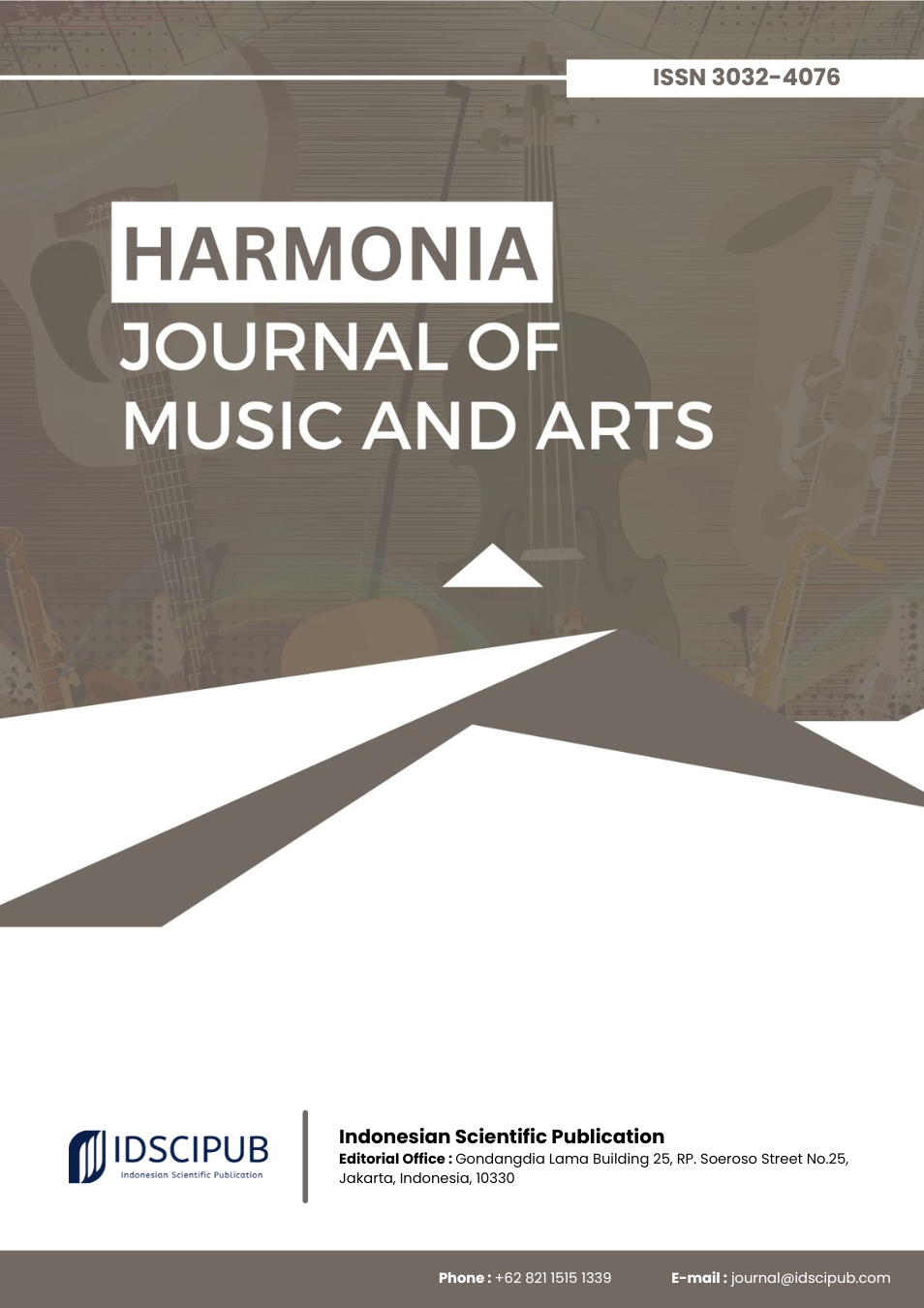Beyond Human Authorship: Exploring Computational Creativity and Machine-Led Aesthetics
DOI:
https://doi.org/10.61978/harmonia.v3i3.912Keywords:
Computational Creativity, Generative Art, Artificial Intelligence in Art, Human–AI Collaboration, Digital Culture, Creative TechnologiesAbstract
The integration of artificial intelligence into artistic practice has transformed computational creativity into a dynamic field where human intuition and algorithmic processes converge. This narrative review examines how human–AI collaboration reshapes creativity, highlighting both opportunities and challenges. A systematic literature search was conducted across databases including Scopus, IEEE Xplore, Google Scholar, and the ACM Digital Library, using keywords such as “computational creativity,” “generative art,” and “human–machine collaboration.” Inclusion criteria prioritized peer-reviewed studies from the last decade, with attention to both technical innovations and socio-cultural dimensions. Findings reveal that collaborative approaches between humans and AI yield more complex and innovative artistic outcomes, supported by techniques such as neural painting and generative music models. Empirical studies demonstrate increasing acceptance of AI-generated art, although biases remain, as audiences often perceive human-made works more favorably. Results also underscore the influence of individual expertise, social interactions, and technological infrastructure on creative processes. Cross-cultural comparisons highlight disparities, with greater acceptance and infrastructure in Europe and North America, contrasted with limited access and cultural ambivalence in developing regions. Discussion points to systemic factors, including policy and education, as critical determinants of adoption and trust. The review concludes that advancing computational creativity requires inclusive access to AI tools, public education to reduce skepticism, and multidimensional evaluation metrics. Future research should expand global perspectives and integrate psychological and cultural frameworks, ensuring equitable participation in the evolving landscape of AI-mediated art.
References
al‐Rifaie, M., Leymarie, F., Latham, W., & Bishop, M. (2017). Swarmic autopoiesis and computational creativity. Connection Science, 29(4), 276-294. https://doi.org/10.1080/09540091.2016.1274960 DOI: https://doi.org/10.1080/09540091.2016.1274960
Bhambri, P., & Khang, A. (2024). The human-machine nexus with art-making generative AIs. pp. 73-85. https://doi.org/10.4018/979-8-3693-1950-5.ch004 DOI: https://doi.org/10.4018/979-8-3693-1950-5.ch004
Brown, A. (2021). Creative partnerships with technology: how creativity is enhanced through interactions with generative computational systems. Proceedings of the AAAI Conference on Artificial Intelligence and Interactive Digital Entertainment, 8(4), 14-20. https://doi.org/10.1609/aiide.v8i4.12555 DOI: https://doi.org/10.1609/aiide.v8i4.12555
Cádiz, R., Macaya, A., Cartagena, M., & Parra, D. (2021). Creativity in generative musical networks: evidence from two case studies. Frontiers in Robotics and AI, 8. https://doi.org/10.3389/frobt.2021.680586 DOI: https://doi.org/10.3389/frobt.2021.680586
Cetinić, E., & She, J. (2022). Understanding and creating art with AI: review and outlook. ACM Transactions on Multimedia Computing Communications and Applications, 18(2), 1-22. https://doi.org/10.1145/3475799 DOI: https://doi.org/10.1145/3475799
Chia, A. (2022). The artist and the automaton in digital game production. Convergence: The International Journal of Research Into New Media Technologies, 28(2), 389-412. https://doi.org/10.1177/13548565221076434 DOI: https://doi.org/10.1177/13548565221076434
Debnath, S., Tiwari, A., & Raman, S. (2024). Scribgen: generating scribble art through metaheuristics. pp. 1-9. https://doi.org/10.1145/3680530.3695448 DOI: https://doi.org/10.1145/3680530.3695448
Deshpande, S., & Purwar, A. (2019). Computational creativity via assisted variational synthesis of mechanisms using deep generative models. https://doi.org/10.1115/detc2019-98193 DOI: https://doi.org/10.1115/DETC2019-98193
DiPaola, S., Gabora, L., & McCaig, G. (2018). Informing artificial intelligence generative techniques using cognitive theories of human creativity. Procedia Computer Science, 145, 158-168. https://doi.org/10.1016/j.procs.2018.11.024 DOI: https://doi.org/10.1016/j.procs.2018.11.024
Dwivedi, D., & Mahanty, G. (2023). Human creativity vs. machine creativity. pp. 19-28. https://doi.org/10.4018/978-1-6684-6366-6.ch002 DOI: https://doi.org/10.4018/978-1-6684-6366-6.ch002
Eldridge, A., & Bown, O. (2018). Biologically inspired and agent-based algorithms for music. https://doi.org/10.1093/oxfordhb/9780190226992.013.18 DOI: https://doi.org/10.1093/oxfordhb/9780190226992.013.18
Franceschelli, G., & Musolesi, M. (2024). Creativity and machine learning: a survey. ACM Computing Surveys, 56(11), 1-41. https://doi.org/10.1145/3664595 DOI: https://doi.org/10.1145/3664595
Giorgetti, I. (2024). Exploring the intersection of art, human creativity, and AI. Itinera, (28). https://doi.org/10.54103/2039-9251/27841 DOI: https://doi.org/10.54103/2039-9251/27841
Goenaga, M. (2020). A critique of contemporary artificial intelligence art: who is Edmond de Belamy? Ausart, 8(1), 51-66. https://doi.org/10.1387/ausart.21490 DOI: https://doi.org/10.1387/ausart.21490
Kowaliw, T., McCormack, J., & Dorin, A. (2011). An interactive electronic art system based on artificial ecosystemics. https://doi.org/10.1109/alife.2011.5954645 DOI: https://doi.org/10.1109/ALIFE.2011.5954645
Peeperkorn, M. (2022). Artificial creative societies: adaption, intention, and evaluation. pp. 704-707. https://doi.org/10.1145/3527927.3533728 DOI: https://doi.org/10.1145/3527927.3533728
Peruzzo, E., Menapace, W., Goel, V., Arrigoni, F., Tang, H., Xu, X., … & Ricci, E. (2023). Interactive neural painting. Computer Vision and Image Understanding, 235, 103778. https://doi.org/10.1016/j.cviu.2023.103778 DOI: https://doi.org/10.1016/j.cviu.2023.103778
Ragot, M., Martin, N., & Cojean, S. (2020). AI-generated vs. human artworks: a perception bias towards artificial intelligence? pp. 1-10. https://doi.org/10.1145/3334480.3382892 DOI: https://doi.org/10.1145/3334480.3382892
Riccio, P., Galati, F., Zuluaga, M., Martin, J., & Nichele, S. (2022). Translating emotions from EEG to visual arts. pp. 243-258. https://doi.org/10.1007/978-3-031-03789-4_16 DOI: https://doi.org/10.1007/978-3-031-03789-4_16
Sugiyama, S., & Burke, C. (2025). Making sense of generative AI for creating art: an exploratory study. First Monday. https://doi.org/10.5210/fm.v30i5.14122 DOI: https://doi.org/10.5210/fm.v30i5.14122
Żylińska, J. (2023). Art in the age of artificial intelligence. Science, 381(6654), 139-140. https://doi.org/10.1126/science.adh0575 DOI: https://doi.org/10.1126/science.adh0575






